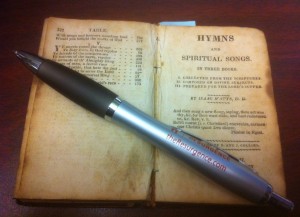Every time I read or sing an Isaac Watts hymn, I gain spiritual insight, devotional fervour, musical appreciation and writing instruction. While reading “I Sing The Mighty Power Of God” just now, two poetic devices leaped at me from this couplet:
Lord how Thy wonders are displayed, where ‘ere I turn my eye
If I survey the ground I tread, or gaze upon the sky
Besides the obvious end rhyme of “eye/sky,” we see these devices:
- Internal rhyme of “displayed/survey/gaze”
- Internal rhyme of “Thy/I/eye” (and of course the end-line rhyme of “eye/sky”)
- Internal rhyme of “how/ground”
- alliteration of the “t” sound in the verbs “turn/tread” (and notice that these are strong, active verbs)
- alliteration of the “g” sound in “ground/gaze”
Each of these devices helps tie the text together, making it easier for us to memorize and sing this great response to God’s call to worship.
WRITING EXERCISE:
Write a song (or even just one verse or a chorus) with at least one use of these two poetic devices:
- Internal rhyme — “rhyme between a word within a line and another either at the end of the same line or within another line.” (Merriam Webster definition)
- Alliteration — “the repetition of usually initial consonant sounds in two or more neighboring words or syllables (as wild and woolly, threatening throngs) —called also head rhyme, initial rhyme” (Merriam Webster definition)
Feel free to post your example in the comments section or send them to us using the “Contact” feature of our About section here at My Song In The Night.
This exercise will help you start thinking about adding “tools to your belt” beyond the typical end rhyme. In fact, you’ll find that using other poetry devices can take the pressure off of having to come up with an end rhyme to a line that doesn’t need one (why end a line with “blue” just because the previous line ended in “true,” just for the sake of rhyme?)
Read the full text of “I Sing The Mighty Power Of God” here. What additional examples of alliteration and internal rhyme do you see?

{ 1 trackback }